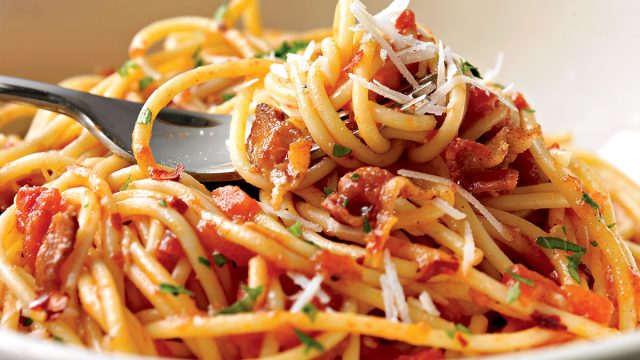Pasta is a delicious, thin pasta and one of the most popular Italian cuisine. However, Italian spaghetti is usually made from hard wheat paste, but is mainly made from milling, water, and is also rich in vitamins and minerals.
This pasta has whiteness because it contains refined flour during production.
A short history of pasta
Pasta consumption dates back to the 5th century AD, from Talmud, pasta subsequently mentioned dry pasta that can be cooked by boiling, just like today’s pasta.
However, after the Italian factory was established in the 19th century, the popularity of the Italian market spread throughout Italy, making the pasta quality mass production in the Italian market also in the 19th century Italian market, with Italian bread offering pasta in Italian Italian restaurants.
Produce pasta
Fresh spaghetti: This pasta is prepared using a pasta machine, the simplest, imitating pasta can be used with no more than rolling pins and knifes. The home pasta machine simplifies rolling and makes cutting more even.
But of course, cutting paper produces pasta with rectangular rather than cylindrical cross-sections, resulting in a variation of tonsils. Some pasta machines have spaghetti attachments with round holes that squeeze pasta or shaped rollers to form cylindrical noodles.
Please read also: Top 10 foods and drinks that may be inflammation
Pasta can be manually rolled on the surface to form a long sausage shape. Pull the ends of the sausage away to make the sausage thin. Put the ends together and pull the loop to make two long sausages.
Repeat the process until the pasta is thin enough. The pasta knobs at both ends are cut off, leaving many chains that may hang up dry.
Fresh spaghetti are usually cooked within hours of formation. Commercial versions of fresh pasta are made.
Dried pasta
Most dry pasta is produced in the factory using a screw extruder. Although it is simple in nature, the process requires attention to details to ensure that mixing and kneading of ingredients will create a uniform mixture without air bubbles.
The mold formed must be waterproof to prevent damage to the pasta by overheating. The drying of the newly formed spaghetti must be carefully controlled to prevent the chain from sticking together and retaining enough moisture to avoid being too brittle. Packaging for protection and display has evolved from paper packaging to plastic bags and boxes.
Dry spaghetti is measured in “spaghetti quantity”. The weight of a portion of the dry pasta is 120 grams, twice as much as a portion on the package, and this measure can be divided into 1, 2, 2, 3 or 4 parts according to the diameter of the circle.
Prepare
Pasta can be cooked in many different ways, here are some tips to guide you on how to cook spaghetti.
Also Read: 12 Best Foods and Drinks to Be Good for the Liver
Cooking Ingredients:
Spaghetti
Spaghetti range
Large pot (for cooking)
Large filter for drainage
(i) First, we first need to apply gasoline and then use a pot of water to cook the spaghetti.
(ii) Wait about 2-3 minutes of water to warm up, then put the pasta in warm/boiled water and wait for another 3-5 minutes.
(iii) While waiting, make sure to pour the pasta in using a cooking spoon to absorb the water, and then line the pasta pasta in the rubber filter basket.
(iv) You can then eat it with your favorite dish.
Pasta cuisine
Pasta can be served in two different ways.
(i) Italian cuisine
(ii) International cuisine
Please read also: Foods with inflammation-striking (anti-inflammatory foods)
Italian cuisine
Classic Spaghetti Alla Carbonara: This is an Italian pasta cuisine that is mainly served on special occasions.
Plus, it is a symbol of Italian cuisine, and spaghetti is often eaten with tomato sauce, which may contain various herbs, olive oil, meat or vegetables.
International cuisine
Pasta bolognese, which is common outside of Italy, but is not a habit in that country
In some countries, spaghetti is sold in sauce.
Is Italy facing my health disadvantage?

Pasta is a high-carb food, your body needs carbohydrates to be energy, and pasta is a great choice for seeking a balanced carbohydrate diet.
Nutritional facts
Pasta Pasta contains many minerals and vitamins, some of which include: calories, sodium, fat, fiber, protein, sugar, and carbohydrates.
Also Read: Mexican Spices – Complete Guide to Rise Meals
Health Benefits
The main reason why pasta pasta is better for you is that it contains more fiber than regular pasta.
As mentioned earlier, it is a high carbohydrate food that makes it an energy food. Fiber is essential for a healthy digestive system.
Allergies and interactions
Pasta is made from wheat, which contains protein gluten. However, gluten is one of the biggest food allergies in adults and children, and people with celiac conditions need to avoid gluten at all.
Symptoms of celiac disease include vomiting, bloating, qi and nausea, and some people may also experience head rashes and headaches due to eating wheat.
Also read: Second-hand edible oil recycling process: a complete guide
Was this article helpful? Please share your thoughts and comments in the comment section below.
